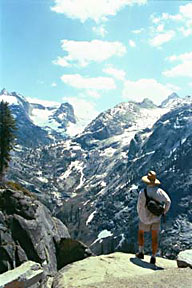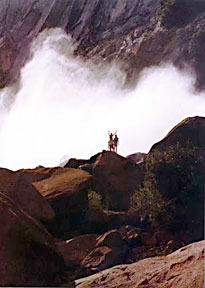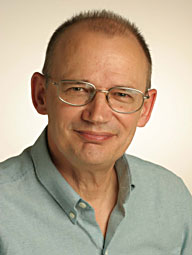 
COVER
STORY | IN THE NEWS | OPINION
THEATER | TALK OF THE TABLE | THE HUM | CALENDAR
November 3, 2005


CHESBRO 2008: It was originally just an off-hand remark, made
to members of the Mendocino Coast Democratic Club last week,
but his press secretary has since confirmed it: State Senator
Wes Chesbro plans to run for the state Assembly in 2008. Assuming
that current California term-limit regulations survive another
12 months (we hear there's talk in Sacramento of modifying them)
Chesbro will be booted from the Senate in 2006. What's a career
officeholder to do? Well, the 54-year-old Democrat's idea is
to take a couple of years off -- perhaps visiting his district
once or twice in the meanwhile -- and come back tan, rested and
ready for a stab at the lower house seat currently occupied by
Patty Berg (D-Eureka), who will herself be termed out at that
point. If elected, Chesbro could then serve a maximum of six
years, according to current rules. But then what? Either up or
down, you'd have to guess: A stab at some minor executive branch
office (state controller?) or an inglorious return to the Humboldt
County Board of Supervisors. Otherwise, appointment to some dreary
commission or task force. Unless isn't it at least possible
that Rep. Mike Thompson (D-St. Helena) could be elevated to the
U.S. Senate by 2014? Put that out of your mind, though. Chesbro
has. "The senator is focusing on the last year of his senate
term for the next 12 months," said Chesbro aide Darby Kernan
Tuesday.
SHERIFF OFFICE SCANDAL: Deputy Mike Gainey has resigned from the Humboldt
County Sheriff's Office after allegedly committing perjury and
falsifying evidence in a recent trial of a McKinleyville man
who was convicted of stalking. As the McKinleyville Press
first reported last week, Gainey allegedly lied on the stand
about forensic tests on an audiotape -- a key piece of evidence
in the trial -- that he had supposedly contracted a company called
Renaissance Recording to perform. It was later found out that
the company does not exist. When confronted with this fact, Gainey
said that he was under a great deal of stress because his father
had recently died -- another falsehood.
Lt. Mike Downey of the Sheriff's
Office said Tuesday that an internal investigation into the matter
should be complete within the next 10 days. In light of these
developments, the McKinleyville man will be retried.
PULP ME:
Every town's got its lurking monster, a beast that rides the
horizon spewing smoke -- or steam -- while wickedly plotting
the villagers' grim demise. For some folks in Humboldt County,
that beast is the pulp mill on the Samoa peninsula. `Course,
the mill's owner, Evergreen Pulp, wouldn't care to view its charge
as monstrous, but rather just as an aging workhorse busy chomping
wood chips into pulpy mash while, admittedly, expelling rather
more particulates than allowed under official environmental standards.
Beast handler and villagers clash regularly in air quality hearings.
The latest was last Friday, before the North Coast Unified Air
Quality Management District board, at which Evergreen Pulp requested
an interim variance to keep operating despite out-of-compliance
emissions from its lime kiln, a 300-foot long, 10-foot diameter
furnace, until a Dec. 5 hearing on a regular variance. The regular
variance would allow the mill to operate yet longer while long-term
upgrades take place. Without the variances, Evergreen warned
Friday, it would have to shut down and lay off 180 workers. With
the variances, countered emotional residents, particulates will
continue to clog their lungs and burn their eyes and, some alleged,
cause or exacerbate an array of horrifying disorders. Evergreen
proposes adding new, state-of-the-art equipment to fix the kiln
problem -- and seems offended, in general, by the animosity cast
its way. On Friday, Evergreen consultants dusted off a 1992 study
by the Desert Research Institute that bespeaks of a greater source
of particulates in the region than the pulp mill: sea salts and
unleaded auto emissions. "The mill is not a significant
contributor to ambient PM-10 [particulate matter less than 10
microns] concentrations," said an Evergreen consultant.
"Is there an elephant out there?" The district's air
pollution control officer, Lawrence Odle, called that study's
conclusions "ludicrous." "The pulp mill is a very
significant source" of particulates for Eureka, Odle said.
He said the DRI study has since been questioned, in part because
the monitoring station the data came from is poorly located.
"There's a 95 percent [chance] that [the mill's] emissions
would not be picked up by that station," Odle said. In the
end, the board granted the variance, on the condition that by
Nov. 21 Evergreen have a damned good plan of action, with a firm
timeline, for monitoring and mitigation for the duration of any
subsequent variances, and for complying with regulations.
FORTUNA FRACAS: Things are getting downright nasty in Fortuna,
and we're not even talking about the burgeoning skinhead community.
Remember when the council voted to have a heart and pitch in
for poor Debi August's legal fees? It seemed like a friendly
gesture, a display of solidarity by the town's leaders and also
a way to avoid future lawsuits. But councilmen Mel Berti, Doug
Strehl and Odell Shelton have another think coming. Dean Lewis,
a Fortuna resident and former mayor claims that the three amigos
committed "grand theft" when they awarded August $52,000
to cover a third of the costs stemming from the 2004 conflict-of-interest
lawsuit brought against her. The criminal complaint was filed
with the Fortuna Police Department and sent to the District Attorney's
office, where the grievance was rejected. Lewis is still on the
warpath, however, saying that the city had no right to hand over
Fortuna taxpayers' money to August and that he will likely pursue
charges though the Humboldt County Grand Jury -- the body that
brought the conflict-of-interest charges against August in the
first place.
BYE BYE, MARBY: This time of year along the Pacific Coast, as
winter approaches, the stubby, long-winged marbled murrelet heads
out to sea and stays there, not to return until spring, when
it flies into the coastal forest to lay a single egg in a mossy
cushion on an old growth redwood or Douglas fir branch. Some
scientists and activists are doomsaying, however, that the coy
tree-nesting seabird -- which, alternating with its mate, makes
food forays to the ocean while raising its single chick -- may
someday soon not have anything to return to if the Bush administration
has it way. That, in turn, could accelerate Brachyramphus
marmoratus marmoratus' plummet to extinction -- a demise
predicted by one Fish and Wildlife Service report to occur within
40 years if the bird goes unprotected. But in late October, according
to news reports, the F&WS admitted it was considering moving
ahead with delisting the marbled murrelet, which under the federal
Endangered Species Act is protected as a threatened species.
This decision comes despite disagreement from the F&WS' western
branch and the state Department of Fish and Game, and follows
a Bush administration ruling in September 2004 that declared
the roughly 20,000 murrelets of California, Oregon and Washington
no different, biologically, from the 900,000-plus murrelets in
Canada and Alaska. The delisting was prompted by a petition from
the American Forest Resource Council, a group whose "mission
is to create a favorable operating environment for the forest
products industry," according to its website. Ever since
the marbled murrelet was listed in 1992, its protected status
has halted or delayed many proposed timber harvests.
NEW TRAIL: For 22 years, Larry Evans has tramped into the
mountains every summer to build backcountry trails for a living,
and to soak up the starry mountain ambience. Winters, he hunkered
down on the North Coast and fought the good fight for the environment
as a volunteer activist. For the past two years, Evans has served
as president of the board of directors for the Environmental
Protection Information Center. He's leaving that volunteer position
for a paid post, beginning Nov. 7, as EPIC's new executive director,
replacing Cynthia Elkins, who now works for the Center for Biological
Diversity. His overall charge, he says, will be "getting
a handle on the details of our wide array of activities"
that embrace "five and a half million acres of forests,
from ridge to sea." Evans says he loved his backcountry
work, but it's time for a change. "I think what EPIC does
is so important," he says. "We represent the ecological
realities that society -- our culture, our economy -- are either
unwilling, or not set up, to face. Another reason I'm doing it
is I have a 9-year-old son, and society's failure to respect
our natural community is robbing him of his future. Humans are
part of nature." Among EPIC's battles that Evans
will guide, while also coordinating fundraising -- protecting
Clam Beach (and snowy plovers) from rampaging vehicles, monitoring
dredge plans and other activity in Humboldt Bay, continuing the
organization's lawsuit against Pacific Lumber Co.'s habitat conservation
plan and scrutinizing timber harvest plans.
TOP
He loved the outdoors
Sierra Institute graduate's
legacy honored with scholarship
by Helen Sanderson
Photos courtesy Sierra
Institute.
 A little more than a month after her son's death,
Patricia Scoggins of Castro Valley still slips into present tense
when talking about her only child. Kenton Dornbush was a 20-year-old
college student, an optimist, a joker, a chess player, a skateboarder.
He loved the outdoors. A little more than a month after her son's death,
Patricia Scoggins of Castro Valley still slips into present tense
when talking about her only child. Kenton Dornbush was a 20-year-old
college student, an optimist, a joker, a chess player, a skateboarder.
He loved the outdoors.
"My son always loved a
sense of community and friendship, having to work with others,
cook with others and make decisions in a group," she said
in a recent phone interview. "It's something he really likes.
It's very important to him."
By all accounts he lived in
the present, and perhaps that makes his departure that much harder
for a parent to accept. But after Dornbush, a UC Santa Cruz junior,
was killed in a car accident on Sept. 27, Scoggins and Dornbush's
father, Keith Dornbush, knew how their son would want his memory
honored. In lieu of flowers, they asked mourners to donate to
a scholarship fund at the Sierra Institute, an outdoors education
program at Humboldt State.
A memorial service was held
a few days after the accident in an area of the UC Santa Cruz
campus that overlooks Monterey Bay. Santa Cruz-area newspapers
depicted the scene, with a large number of friends and family
wearing Hawaiian-print shirts, listening to Dornbush's favorite
Bob Dylan tunes, reminiscing and keeping the mood lighthearted,
the spirit for which the young man was best known. They talked
about his big hiking trip and how it gave him a deep philosophical
outlook on life.
In the summer of 2004, Dornbush
joined a nine-week course with the Sierra Institute. The 12-unit
class is called California Wilderness: Nature Philosophy, Religion,
Ecopsychology. Scoggins remembered when her son pitched the idea
of taking the class to her: "I have to do this," he
said one day over lunch.
The group of 13 hiked through
the Yolla Bolly Wilderness, camped in the Covelo Hinterlands
and San Luis Reservoir, backpacked through Kings Canyon and Sequoia
National Park and explored Inyo County's White Mountains, along
Cottonwood Creek.
"It was his first big backpacking
trip," Scoggins said. "Sequoia National Park was a
place he really fell in love with. He would talk about it forever."
Dornbush was an avid nature
photographer and got his start with Thrasher, a skateboarding
magazine. Snapping the perfect shot, freezing a stunning moment
in time, meant a lot to him and throughout the summer he lugged
a heavy tripod everywhere. Sierra Institute Instructor Willow
Abel, who attended Dornbush's funeral services, told Scoggins
that her son was very attached to that tripod.
"[Willow] would say to
him, `You know, we're hiking eight miles uphill today, I wouldn't
bring that if I were you.' But he didn't care, he brought it
anyway," Scoggins said.
Keith Dornbush said that his
son was a transformed person after the expedition.
"When he left, he was still
kind of like a kid," Dornbush said with a shaky voice, pausing
and apologizing as he regained his composure during a phone conversation.
"When he came back he'd really become more of a man."
In the weeks that have followed
his death, 24 people have contributed to the Kenton Dornbush
Scholarship fund at HSU.
Ward Angles, program coordinator
for the Sierra Institute, said that so far, $1,480 has been collected.
The intention of the fund is to defray some of the costs for
students unable to afford the full price of the program, which
can run up to $3,000. Financial aid is hard to finagle for students
who attend universities other than HSU.
"What happened is so sad,"
Angles said. "But the scholarship has given some new opportunities
for the program. It validates that the instructors are doing
a worthwhile job."
Angles said that other Sierra
Institute students, like Dornbush, have described feeling like
a different person after the trip.
"For many of the students
it is the best thing that happened to them," Angles said.
"They say things like, `For three years I went to such-and-such
campus and I wanted a different experience from my education,
I wanted to learn about nature in nature, not just in
the classroom."
While most of the participants
are students, Angles points out that anyone over 18 can take
the course, but groups are small and often there is a waiting
list.
On Monday, Angles was sorting
applications for the winter session. Courses on rainforest field
studies and the natural history of the Patagonian Cordillera
will take place in South America from early January into March.
In the spring, as the weather
warms, a new group of students will take the same course Dornbush
did, trekking through the California wilderness, working as a
team, admiring the enduring sequoias. By then, maybe one of them
will get some scholarship money to make the trip possible. And
when it's over, maybe they'll be a new person, too, with a deeper
appreciation for the outdoors, and for living.
TOP
9 Questions for
Wayne Gould
by Hank
Sims
 STARTING
THIS WEEK, the Journal proudly adds the wildly popular
puzzle Sudoku to its [printed] pages, where it joins David Levinson
Wilk's witty crosswords. To mark the occasion, the Journal
exchanged e-mails with Wayne Gould, whose one-man Sudoku house,
Pappocom, has turned the game into an international phenomenon
in the last year. STARTING
THIS WEEK, the Journal proudly adds the wildly popular
puzzle Sudoku to its [printed] pages, where it joins David Levinson
Wilk's witty crosswords. To mark the occasion, the Journal
exchanged e-mails with Wayne Gould, whose one-man Sudoku house,
Pappocom, has turned the game into an international phenomenon
in the last year.
Gould [left] was a judge in
Hong Kong when he first discovered Sudoku on a trip to Japan,
where it has been popular for some time (the name of the puzzle
is said to derive from Japanese words meaning "numbers singly").
He was so captivated by Sudoku that he spent several years writing
a computer program to generate new puzzles. (That program is
now available on Gould's website, www.sudoku.com, along with
a wealth of tips, tricks and discussions for hard-core Sudoku
fans.)
Just one year ago, he began
syndicating the puzzle in The Times, one of the leading
British newspapers. They were an instant hit. Since then, hundreds
of newspapers from all six continents have picked up his puzzles.
|
1. Sudoku has exploded in popularity
in the English-speaking world over the last year, and you've
become something like a Sudoku evangelist. What do you think
accounts for the speed in which Sudoku has caught on? Why did
the world seem to need this puzzle so?
We have been in the thrall of the crossword
and the word-game puzzle for so long, we had forgotten that there
are other kinds of puzzles. Sudoku is language-independent, so
there were no obstacles to its spread across international boundaries.
2. Before discovering Sudoku, you worked
in the legal profession -- a calling that requires (or should
require) strong powers of logic and deductive reasoning. Do you
think that logic is like a muscle -- the more you exercise it,
the stronger it grows? In other words, could Sudoku be more than
a mere time-waster?
Definitely, it is possible to exercise
and improve your logic. Most Sudoku solvers will see their solving
times come down, the more they do. You can dismiss it as just
"practice," if you like, but whatever you call it,
people are achieving things with logic that they could not do
when they began.
3. You were born in New Zealand, you
worked in Hong Kong, you're published in the U.K. and you live
part-time in the United States. Have you noticed any broad cultural
differences in the way that these countries have responded to
Sudoku, and can you draw any conclusions, however tentative,
from such observations?
No, the response has been pretty uniform,
around the globe. Humans like to be puzzled, and to overcome
a puzzle. It's as fundamental as that.
There are a few differences, in some countries.
The British tend to like their puzzles (not just Sudoku, but
puzzles generally) to be very hard, whereas in the USA we like
something that we can be sure to solve.
4. Since you introduced Sudoku in England
last year, newspapers there have developed all sorts of baroque
variations on the theme -- 3-D Sudoku, Sudoku with added arithmetic
challenges, etc. In your opinion, do these versions of the puzzle
lack the elegance of the basic 9x9 grid?
There is a place for the variants. Most
of them are entertaining, but they may not have the longevity
of the basic ("classic") Sudoku puzzle.
5. According to the Wikipedia, the puzzle
was created by a man named Howard Garns in the 1970s. Have you
met Mr. Garns? Have you met any of the Japanese Sudoku setters?
The Wikipedia entry is wrong. No one knows
who invented the puzzle. The gentleman you name may have
been responsible for a known appearance of the puzzle in the
U.S. (even that has not been proved to my judge's satisfaction),
but even if so, that doesn't mean that he invented it. (If the
Japanese and American records were wiped out, it might appear
that I invented the puzzle, but I didn't.)
My own theory is that some academic mathematician
posed this puzzle as a variation of the curiosity that mathematicians
know as the Latin Square.
6. Does Sudoku ever work its way into
your dreams?
No.
|
Sudoku 101
by WAYNE
GOULD
Here's a puzzle with numbers. Do you have
to use arithmetic? No! Nothing has to add up to anything else.
Instead, you solve the puzzle with reasoning and logic.
Fill in the grid so that every row, every
column and every 3x3 grid contains the digits 1 through 9. That
means that no number is repeated in any row, column or box.
Where do you start solving a Sudoku puzzle?
Anyplace you can!

For example, take a look at this puzzle.
Let's try and place a 7 in the top-left box (call it "box
1"). You could just guess where the 7 goes, but that might
get you into trouble. It's more fun to reason it out.
Note the 7 in box 3 (the top-right box).
It's the 7 for the whole top row, so the 7 for the box 1 cannot
go in Box 1's top row. Box 2 also has its 7 already. It is the
7 for the whole 2nd row, so the 7 for box 1 cannot go in Box
1's middle row. That leaves just the 3rd row. In box 1, there
is only one empty cell in the 3rd row -- so we can write the
7 in, between the 9 and the 2.
Now let's try and find the 6 for box 1.
If you look down at box 7 (the bottom-left box), you will see
it already has a 6. That is the 6 for all of the 1st column --
and of course you can only have one 6 per column. Box 4 (the
middle-left box) also has its 6. That 6 is the only 6 allowed
in the 2nd column. So the 6 for box 1 must go in the 3rd column.
This time, there are two empty cells left in box 1. However,
look to the right. There's a 6 in box 2, and it eliminates one
of the possible locations for the 6 in box 1.
With that kind of thinking, you can finish
the Very Easy and Easy puzzles. The Medium puzzles will need
a little extra. You will need some other tricks and techniques,
but discovering them for yourself is part of the fun. The Hard
puzzles, however, will need a lot extra!
Each Sudoku puzzle from Pappocom has just
one solution.
Each Sudoku puzzle from Pappocom can be
solved using logic alone. If you prefer guessing, you can --
but there is a logical way to solve every puzzle.
|
|
TOP
COVER
STORY | IN THE NEWS | OPINION
THEATER | TALK OF THE TABLE | THE HUM | CALENDAR
Comments? Write a
letter!

© Copyright 2005, North Coast Journal,
Inc.
|



 A little more than a month after her son's death,
Patricia Scoggins of Castro Valley still slips into present tense
when talking about her only child. Kenton Dornbush was a 20-year-old
college student, an optimist, a joker, a chess player, a skateboarder.
He loved the outdoors.
A little more than a month after her son's death,
Patricia Scoggins of Castro Valley still slips into present tense
when talking about her only child. Kenton Dornbush was a 20-year-old
college student, an optimist, a joker, a chess player, a skateboarder.
He loved the outdoors.

